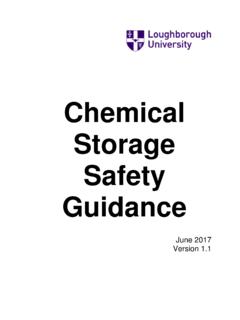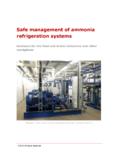Transcription of Fire Hazards from self-heating at Composting and …
1 R3 environmental technology limited BRE 1. Fire Hazards from self-heating at Composting and waste processing Sites Steve Manchester1, Paul Bardos2. Introduction Fires involving materials being stored or processed in bulk can have severe impacts on the local communities and the environment. It is important that site managers at municipal recycling facilities (MRFs) are aware of all the potential fire Hazards that exist on their sites in order for them to produce a comprehensive fire safety plan and an effective risk assessment. This article is intended to highlight the potential fire Hazards that exist on sites that handle large quantities of combustible waste , focussing particularly on the Hazards arising from self- heating leading to spontaneous combustion. It does not cover hazardous waste disposal facilities. The focus of this article is to outline common fire problems in material stockpiles.
2 A. future article will discuss fire risks from waste processing at MRFs. Combustible materials stored and used in bulk that may be found on these sites include: Compost Tyres Wood chips/sawdust refuse derived fuel (paper/ plastic pellets or floc). raw refuse fractions of separated refuse ( paper rich, plastic rich these may have been compacted). textiles Stockpiles are not the only potential source of fire risks. Other sources include processing steps, in particular pulverisation and shredding, and also biofilters which are in effect stockpiles of compost or other materials such as woodchips. It is not the purpose of this article to offer comprehensive guidance. All waste management facilities should undergo a comprehensive risk assessment for fire risks, which is the basis around which the latest fire safety legislation is written see text box. In addition to complying with the various legislation concerning fires, additional regulations will need to be followed, such as planning permission and Pollution Prevention and Control Regulations 2000.
3 (PPC), which also have aspects relating to fire safety and the limitation of damage to the environment from fires ( the complete containment of fire water run-off in the event of a fire). 1. Building Research Establishment Ltd, Watford, 2 3. r environmental technology limited, Reading, r3 environmental technology limited BRE 2. Fire Safety Legislation General health & safety legislation, and fire safety legislation is set out in EU Directives and UK regulations. The basis of European Health and Safety legislation is the Framework Directive: Council Directive 89/391/EEC 12 June 1989 on the introduction of measures to encourage improvements in the safety and health of workers at work. This Directive contains general principles on employers duties. A risk assessment approach is specified that identifies potential Hazards and sets out a series of measures that combine prevention of risks and protection of the workforce.
4 The Framework Directive is implemented in UK law by: Management of Health & Safety at Work Regulations 1999. The duties that an employer has in minimising the risk of an explosion in the workplace is set out in the EU ATEX 137 Directive: Directive 1999/92/EC on minimum requirements for improving the safety of workers potentially at risk from explosive atmospheres. This has been implemented, and extended, in UK law by : The Dangerous Substances and Explosive Atmospheres Regulations 2002. DSEAR sets out UK law for the management of fire and explosion risks arising from dangerous substances in the workplace, this includes flammable gases, liquids and dusts and also materials that are liable to self-heat. Regulations concerning fire safety requirements in the workplace are implemented in the UK by the following: The Building Regulations. Part B Fire Safety. 2000. The Fire Precautions (Workplace) Regulations 1997.
5 (as amended 1999). The Fire Precautions Act 1971. The Supply of Machinery (Safety) Regulations 1992. Compost There are a number of potential fire Hazards at Composting sites, resulting from the operations for compost preparation and refining, and the storage of materials. The possible sources of ignition include: sparks form vehicles and processing operations, lightening, arson, cigarettes and also the spontaneous combustion of materials stored in bulk. o Large compost heaps can generate temperatures of up to 80 C as a result of biological processes of organic matter decomposition. Typically this requires large volumes of relatively fresh materials. The decomposition also requires the presence of moisture. There are a [1,2]. number of papers in the technical literature suggesting that temperatures in large piles of o organic material can then rise above 80 C, as a result of chemical oxidation processes, to a level sufficient to cause ignition.
6 R3 environmental technology limited BRE 3. self-heating ' is the occurrence of a rise in temperature in a body of material in which heat is [1,3,4]. being generated by biological and chemical processes taking place within the material . In certain circumstances the temperature rise may increase both in magnitude and rate sufficiently to culminate in combustion; that is, there may be a self-ignition' or spontaneous ignition'. In some materials biological heating is an indispensable prelude to self-ignition. The materials concerned are generally commodities such as hay, grains, oilseeds, vegetable and animal fibres. Compost heaps usually contain one or more of these types of materials and are hence susceptible to biological heating. For microbiological action to occur a moisture level of between 25 40% is required. However, the maximum temperatures achieved by biological action alone are only around 80 C.
7 At this stage, oxidation reactions take over, resulting from the chemical changes from the initial microbiological reactions, and lead to higher temperatures being generated. The temperature rise associated with the biological and chemical oxidation reactions will depend on the difference between the rates of heat generation and heat loss to the surroundings. Hence, the geometry of the compost heap is a critical factor in determining the rate of heat loss. A single large pile has a small surface area to volume ratio that many smaller piles of the same volume of material, and hence is more likely to self-heat due to the less efficient heat loss capability. Internal charring characteristic of self-heating Spontaneous combustion has been suggested to be the cause of a number of fires at waste [5,6]. Composting facilities in the USA and the UK . Spontaneous combustion has even been suggested as a cause of domestic fires from home compost heaps.
8 Other sources of ignition such as arson, discarded cigarettes and sparks from processing operations can also lead to fires involving compost, however the fires started in these instances will be surface fires that r3 environmental technology limited BRE 4. are relatively easy to control and extinguish. Deep-seated spontaneous combustion fires are much more difficult for fire-fighters to tackle and can take many weeks or months to extinguish. Two recent incidents in the UK highlight the problem. A fire occurred at a large Composting [7]. facility near St Albans . The fire initially started in the summer of 1999 and required the closure of a road for a number of days. The smoke from the fire drifted across two motorways (M1 and M10) and required the attendance by the Hertfordshire Fire Service on more than one occasion as the fire burned for a number of months. The latest fire at the site occurred in August 2003 when the Fire Service was called to a deep-seated fire in the compost which [8].
9 Took a number of weeks to control. In Swanley, a fire was reported in September 2003. involving 100 tonnes of compost and rubbish that caught fire accidentally. Tyres Fires involving stacks of new or waste tyres can have an enormous impact on the local environment due to the production of : Toxic fumes composing: carbon monoxide, carbon dioxide, acrolein, benzene, sulphur dioxide, carbon disulphide and hydrogen sulphide. Particulates from the thick black smoke produced. Pollution from leachate run-off from the water used to fight the fire. Intense radiation produced from these fires which could cause ignition to surrounding materials/buildings. Another feature of fires involving tyres is that they are extremely difficult to extinguish. A fire [9]. started in a tyre dump in South Wales in 1989 burned for at least 10 years. This was mainly due to its location and the size of the pile, making access to the seat of the fire very difficult.
10 The geometry of the tyres also makes its difficult for water to penetrate into the centre of the pile, resulting in the outer tyres being extinguished but tyres in the centre continue to burn. The problem of access to the seat of the fire is a particular problem when the fire has started by spontaneous combustion, as the very nature of the ignition involves the initial fire growth being at the centre of the stockpile rather than on the surface. Hence, when planning bulk storage, the location as well as quantities of materials need to be addressed in the risk assessment. There are a number of potential sources of ignition of tyre stockpiles, these include: Arson Radiation from neighbouring fires involving buildings or other materials tyres can 2 [10]. ignite at as low a heat flux as 9kW/m . Naked flames from bonfires or repair/maintenance work self-heating rubber has the capacity to undergo self-heating reactions leading to spontaneous combustion.







